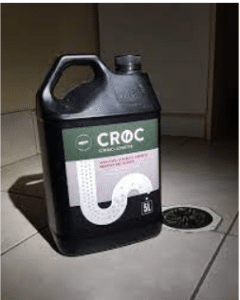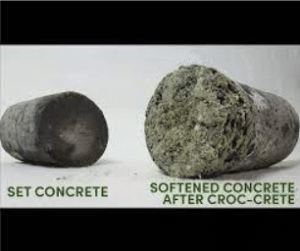How to Remove Concrete Splatters Easily
Do you want to know how to get rid of concrete splatters on bricks, tiles, conduits and drain pipes? Well, one of the most prevalent reasons for concrete to end up in unexpected places is shoddy construction work. Whenever the construction crew doesn’t take the necessary precautions when doing construction work on the property, loose cement, concrete, mortar, grout, stucco, etc. starts to get splattered on bricks, tiles, facade, conduits, and even down the plumbing system. As this loose construction material sets and hardens, it forms a hard lump that needs to be either painstakingly chiseled away or be treated with a chemical solution.
Bricks are challenging because concrete splatters are hard to see until the concrete has dried. It is significantly harder to remove as a result.
Here are a few techniques to remove concrete splatter from bricks that you can try.
Start with prevention
Let’s start with some preventative advice since the best course of action is to avoid the concrete splatter in the first place. When dealing with concrete, always be aware of your surroundings, especially if there are bricks nearby. To prevent spills from coming into contact with unintended surfaces, place down sheets or plastic.
Always wipe up concrete spills right away to prevent drying. Hardened concrete also always carries the danger of unintentional injury. Brick surfaces can have disturbed spills removed with a strong brush and water.
Get Rid of Big Concrete Blocks
Large concrete splatter chunks should ideally be removed first before attempting any other techniques. To put it another way, if the splatter is thick, you can try chipping away the bigger pieces before trying another approach.
When you consider it, this makes sense. It won’t be effective to use acid or concrete dissolvers on large spatter chunks. Larger sections of concrete are better to chisel since there is less chance of surface damage. All you have to do is use caution.
Apply Croc Crete Down Drain Pipes to Remove Concrete Splatter
The best method for getting concrete splatter off of drain pipes is to use Croc Crete mortar dissolver. It doesn’t endanger the surface and is safe. Plus, it works incredibly well. Concrete is attacked by Croc Crete’s heavy duty concrete dissolver which then turns it into a fluid state that is easily removed.
That being said, just to be safe, always use protective gear when applying Croc Crete, and always test small portions first. Croc Crete is not to be used as a DIY, so please contact a plumbing specialist to handle Croc Crete for you.
Use Muriatic Acid to Remove Spillage
This is usually the go-to method for homeowners but it’s also the most hazardous one. A lot of things can go wrong when using acid. Follow the proper safety techniques to avoid the risks associated with acid. This includes covering all exposed skin with protective clothing, wearing goggles, and a mask to avoid fumes.
Muriatic acid is the most common acid. It’s found at most hardware stores. Always read the product label and follow it to the letter.
Instructions
Spray the area with water so that the surrounding brick doesn’t get damaged if it comes into contact with the acid. Acid will cause dry bricks to take on a yellowish color, which is an aesthetic nightmare.
Add water to acid according to the product instructions. Use a clean bucket to mix the two together. A word of caution though. Always add water to the bucket first and then pour in the acid second. Never pour water into acid since this leads to a dangerous reaction and splattering.
Apply the acid to the concrete splatter using a brush. Be careful not to get any acid on the surrounding brick. The solution will react to the concrete by bubbling.
Allow the acid to remain in contact with the concrete splatter for the time specified on the product label. Do not allow the acid to remain in contact with the concrete for any longer than the specified time listed on the product label. If the time is not listed, then move on to the next step immediately.
Scrub the affected platter with a brush to remove the concrete splatter.
Rinse the area with water to remove any residual acid. Use a mixture (1:1 ratio) of ammonia and water to neutralize the acid.
Repeat all steps if concrete splatter remains.
Downsides to Using Acid to Remove Concrete Splatters
Acid comes with a ton of risks so it’s not recommended. Health is the primary concern. Acid poses a lot of risks to humans with fumes being at the top of the list. Always ensure the area is well-ventilated since acid fumes will lead to permanent damage.
But human health isn’t the only concern. Acid easily damages brick so it runs the risk of causing extensive damage. We briefly mentioned discoloration but another risk is damage to the mortar holding bricks in place. Acid doesn’t discriminate. It eats mortar just as easily as it does concrete splatter.
Due to its risky nature, we recommend that you save acid as a last resort and refer to one of the other methods on this list.
Chisel Away Unwanted Cement
Chiseling away excess concrete comes with a few risks, the biggest of which is damage to brick surfaces. It’s still a safer option than acid though. Plus it’s much cheaper.
The first important note is that homeowners with no experience should not attempt to chisel. It’s a delicate job that requires precision over brute strength.
Instructions
Make sure you wear a pair of goggles when chiseling concrete to protect your eyes from loose particles.
Gauge the size of the concrete splatter to decide the size of the tools required for the job. It’s possible to clear small splatters without a hammer so keep that in mind.
Soak the entire surface with water to lower the risk of brick damage. This also prevents concrete shards from dislodging from the surface when chiseling.
Place the chisel so it’s parallel with the brick before applying the hammer. Do not ever aim the chisel directly at brick or it will get damaged.
Apply a few light taps to the chisel to break away the concrete splatter. Don’t get too carried away here. Light taps avoid damaging the bricks.
Clean away loose concrete with a brush. Again, don’t apply too much pressure or else the brush will damage the brick.
Repeat steps until the concrete splatter is gone.
Downside to Chiseling
Chiseling is less risky than acid but is not without its own hazards. Fragments of concrete break away and get into the eyes. Fortunately, safety goggles will eliminate this problem.
The main risk is that chiseling has the potential to damage the brick surface. Only attempt this if you have experience with chiseling and are confident that you can do so without damaging the brick surface.
Key takeaways
The best option to remove concrete splatter from conduits, drain pipes and plumbing systems is Croc Crete, simply because it is a concrete remover that is tailored for pouring down all kinds of drainage pipes without causing any harm to any component of the plumbing system.
Additionally, it is safe for the environment, so neither your plumbing nor the environment are at risk. The only thing that Croc Crete destroys is the concrete, cement, mortar, grout and stucco blockage in your drainage system. However, this is not a DIY cement dissolver. Therefore, you should still use caution and only let a plumbing specialist use Croc Crete on your property. Get Croc Crete today!

